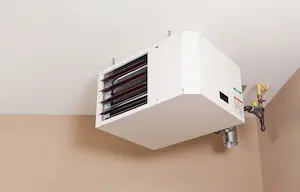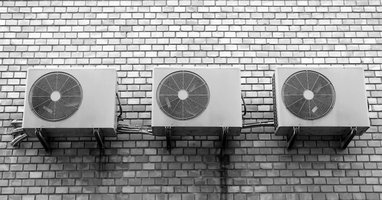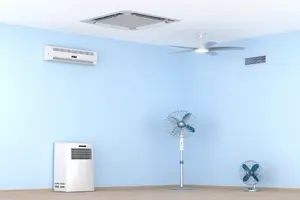How To Install Garage Heaters (Helpful Videos & Info)
This post contains affiliate links.
Garage heaters are essential, especially during the winter months. This is because they help to ensure the garage air stays warm, allowing you to spend time in it. However, how do you install a garage heater?
To install a garage heater:
- Prepare the tools and materials.
- Determine the proper place to mount the heater and pull pipes and wiring.
- Mount the heater
- Install the gas pipeline.
- Perform wiring and venting.
- Test and troubleshoot
In this article, we explore how you can install a garage heater. We also look at some of the common questions you may have about the garage heater itself.
How To Install Garage Heaters
Installing a garage heater is not rocket science, but it is not a walk in the park either. You need to put in some effort to understand how the system works. It would help if you also thought about where to mount and ensure you install things properly.
If you have experience in DIY work or are confident enough in your work, do it yourself. However, also check with your local authorities if you are allowed. This is because some areas require a heater to be installed by professionals.
We assume you are installing a standard natural gas heater for the steps below. The steps to install other types of heaters may differ from the ones below.
Prepare The Tools & Materials
The first step to installing a garage heater would be to prepare the tools and materials. Ensure you have this list of items ready before you commence any work:
Tools
- Screwdriver kit
- Multitool kit
- Adjustable wrench or wrench set
- Cordless drill
- Pipe wrench
- Plumbers tape
- Tape measure
- Ladder
Materials
- Gas lines
- Gas line connectors
- Heating unit
- Vent pipes
Safety Equipment
- Eye goggles
- Work gloves
- Respirator
- Helmet
All the tools you could ever need are listed in this article.
Measure, Measure, Measure
To start your work, you need to first spend some time measuring. From the measurement, you can then decide on many things, such as:
Where To Mount Your Heater: Mounting your heater higher up lets it dissipate warm air across a wider space. However, installation may become difficult. You also need to consider wiring and lines too.
Some heater types, such as infrared, have specific requirements. They have to be installed at least 7 feet above the floor. It also must have a minimum clearance of 4 inches from the ceiling.
Where To Run Wiring To Your Heater: You must also think and measure up on the wiring. You may need to run longer wiring lines depending on your mounting position. Ensure you have enough wiring to avoid going to the hardware store later.
Where To Run Gas Lines To Your Heater: The next thing is to gas lines. Ensure you have taken down the exact length of gas lines needed before you purchase and assemble one.
Mount The Heater
The next process would be to mount the heater. In most cases, the work process is as the below:
Mount The Brackets: Your heater should come with a bracket. Secure the bracket to the wall first before placing your heater into it. In most cases, some drilling is needed here.
Sit In The Heater: Sit your heater into the bracket. While performing the task, ensure the heater is seated properly. It should face the right direction, not wobble, and feel stable.
You also want to check that you can access the gas, vent, and electrical connections. This prevents you from having to dismount the heater again later. This can happen if you cannot access the connections during the connecting work.
Install The Gas Pipeline
Now that the heater is properly seated, you can now start putting it in the gas pipeline. Before you start, ensure you are using the right gas pipe. Check with your heater manufacturer’s instructions to confirm.
You also want to think about the assembly process. Ensure you use high-quality joint compounds. This ensures the pipeline does not leak under high gas pressure. Also, ensure the gas lines are securely attached to the heater. Your line should also attach securely to the underground main gas line.
Finally, confirm with your local building code. Make sure your installation adheres to the guidelines. You do not want a fine from a house inspector later.
Wiring And Venting
With the gas lines secure. The next step would be to perform wiring and venting work. This is where many may feel a little unsure since not many of us have the knowledge to perform electrician work.
You also need to think about where to mount your thermostat. In this case, check with your manufacturer to ensure you are mounting it in the right place.
If you are unsure of your ability, it may be better to hire a professional to wire up the heater. They may also be able to check your gas lines to ensure they are put in properly.
Test Run And Troubleshoot
With the heating systems now set up, it is time to test run it. This allows you to see if everything is working well.
As you test run the heater, ensure to monitor it closely. Observe if there are any gas leaks, abnormal warming on parts of the heater, or anything not usual. If yes, turn off the heater immediately, and troubleshoot.
You should only finish this process when the heater runs well and has no abnormal operation.
FAQ
Where Should I Place My Garage Heater?
Where you should place your garage heater may depend on many factors. They include type, space, efficiency, and more.
Type: Certain types of heaters may have height requirements. For example, Infrared heaters must be placed at least 7 feet above the floor. It should also be at a minimum of 4 inches from the ceiling.
Garage Space: If your garage does not have adequate space to host a heater, you may need to mount it higher up. This may complicate installation but frees up the lower wall space. You can then add cabinetry or a workbench.
Efficiency: Certain heaters work better when mounted at a certain position. For example, a forced air heater may work better if operating from a higher position. The key is to place the heater at a centralized location in your garage.
Safety: Heaters with flame, such as gas and propane heaters, should be high up. This prevents other things from catching the flame and starting a fire.
Fuel: Your heater’s placement may also depend on the fuel sources. For example, you want your heater close to the gas lines or an electric outlet to make installation easier.
How Much Does It Cost To Professionally Install Garage Heaters?
The actual cost to heat a garage may depend on your fuel choice, heater rating, and how frequently you use it. There are also installation costs to add in too.
If you hire a plumbing professional or an HVAC expert, the average installation price is about $500 to $2,000. However, the actual installation cost may depend on many other factors too.
These factors include the labor rate at your location and the installation job itself. If the installation job is complicated or requires teardowns, it may cost more too.




